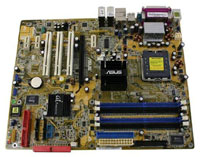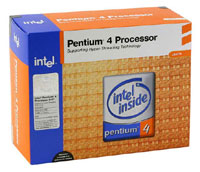Buyer's Guide - Mid-Range, January 2005
by Jarred Walton on January 21, 2005 11:09 AM EST- Posted in
- Guides
Intel Motherboard and CPU Recommendations
The Intel side of things is a little less difficult to assess. There haven't been any major developments lately that are due to upset the balance, so things remain largely unchanged. The impending launch of the 600 series processors will hopefully breathe some new life into the platform. With the lowest clocked models scheduled to run at 3.0 and 3.2 GHz and targeting a reasonable $200-$300 price according to recent Intel roadmaps, the Prescott 2M is definitely something to think about if you're not in any particular hurry. The additional L2 cache should boost performance to beyond current Pentium 4 Extreme Edition levels - the L2 cache is faster than L3 cache, remember - and given the much lower pricing of these mainstream oriented processors, it seems unwise to make a large investment in a high-end Pentium 4 right now. In the Mid-Range, however, price/performance is not likely to be dramatically different from current options, with an extra 10% to 15% performance coming from the cache upgrade. Waiting a few months for a 10% performance increase is just delaying the inevitable, so here is our Intel suggestion.
 |
 |
| Click images to enlarge. | |
Intel Platform Recommendation
Motherboard: ASUS P5GD1 (915P)Price: $116 Shipped
Processor:Pentium 4 540 (3.2 GHz) for 775 (Retail)
Price: $215 Shipped
While we haven't given the P5GD1 [RTPE: ASUS 915P P5GD1] a formal review, it shares many similarities with the Gold Editor's Choice P5GD2 from our 915P motherboard roundup. We chose the "lesser" board for a couple of reasons. First is price, with the P5GD2 generally costing $30 more than its little brother. The bigger factor also plays into price: the P5GD1 uses DDR RAM instead of DDR2. DDR2 continues to cost quite a bit more than regular DDR memory, and it has yet to show a tremendous performance advantage. Unlike the AMD options, there really doesn't seem to be any point in avoiding PCI Express on the Intel platforms, as you would have to opt for an older chipset and fewer features in order to go that route. This can be good or bad, depending on the graphics card that you plan on using, but we'll get to that topic shortly.
As far as features go, the ASUS board has pretty much everything that you could want. The integrated gigabit Ethernet (GbE) is on the PCI Express bus, so performance is not limited by the slower PCI bus. That really doesn't seem to matter too much, however, as nearly all GbE setups that we've tested can handle 30 to 40 MB/s transfer rates, which is usually as fast as any non-RAIDed hard drive setup. Only serious networking types are likely to be concerned with maximum GbE performance. One minor shortcoming is that unlike the P5GD2, ASUS decided to use a cheaper non-HD audio solution. We would have preferred the Azalia HD solution, but the Realtek ALC861 8 channel audio is plenty good. If you plan on adding your own sound card, this becomes a moot point, but we certainly don't feel that better sound hardware is necessary.
For the processor, we try to keep things relatively close to the price and performance of the AMD system by going with the 3.2GHz Pentium 540 [RTPE: BX80547PG3200E]. We actually end up being slightly cheaper than the AMD platform here, due to the lower cost of the motherboard, but overall, the AMD system will often outperform the Intel system, so that seems fair. There are still areas where Intel leads in performance, most likely due to better optimizations for their architecture; so if gaming isn't your primary concern, it becomes more of a toss up. A slight upgrade in performance via the P4 550 is also something to consider, but for a $60 price increase, you only get an extra 200MHz, so it's not a great bargain.










46 Comments
View All Comments
Rocket321 - Saturday, January 22, 2005 - link
Could someone explain what has changed between the NEC 3520A and 3500A. I checked the Anandtech Fall 16x roundup and it has the 3500A listed as DVD-R 16x.Dranzerk - Saturday, January 22, 2005 - link
Mmm, i bought my 930sb from Newegg about 6 months ago, guess they ran out fast. Oh well. :(N3cr0 - Saturday, January 22, 2005 - link
Well, I think I may go with the system described with the ASUS board but a 3000+ processor to save some cash. As it stands right now, anything is an upgrade from my Celeron 1.2 system. The XFX 6600GT is also available for dramatically less then the Leadtek (40-50$ less) 6600GT, so I'm going to be going with that also.Zebo - Saturday, January 22, 2005 - link
"The Diamond Pro 930sb Mitsubishi monitor is also a excellent CRT choice for 19inch."Too bad no one sells it:(
Zebo - Saturday, January 22, 2005 - link
KILLER CHOICES!!!'Another good mobo is epox 9NDA3J... it's $45 less than MSI..same clocks many say better with new bios. I post at 330 HTT now vs 315 before.. My mem OCs much more too..
JarredWalton - Friday, January 21, 2005 - link
20 - NEC and Mitsubishi "merged" on the monitor segment. The NEC FE991SB is almost the same monitor as the Diamond Pro 930SB. The 930SB did have a few advantages, like a 110 KHz hoizontal scan rate and a slightly higher max resolution, and perhaps a few cosmetic differences.Unfortunately, the 930SB is no longer available online as far as I can tell (and it did cost a bit more). That's why it's no longer in the Guide. If you can find one, it's still a great monitor, although I wouldn't pay much more than $285 for it.
Dranzerk - Friday, January 21, 2005 - link
The Diamond Pro 930sb Mitsubishi monitor is also a excellent CRT choice for 19inch. Very nice monitor, gets great reviews, and cheap to boot.I beleive it used to be Anandtech buyers guide..maybe another type? check it out
JarredWalton - Friday, January 21, 2005 - link
#17 - certainly something to think about, although there are so many possible causes that a lot of people don't tend to list in forums. For example, are they overclocking? What sort of PSU are they running (as a 300GB three platter hard drive inherently uses more power than an 80GB one platter drive)?Most of the posts seem to be related to having RAID issues. I won't even get into the subject of RAID, but having two of those drives running is going to further increase the power demands. What sort of GPU do they have, CPU, etc.? People looking at running two or even three $200 drives are probably putting in other high-end hardware as well, and a 480W PSU - even a quality Antec, Enermax, etc. - may not be able to handle the power demands.
Anyway, the Maxtor is merely listed as an alternative. Plenty of people are using them without any problems, but they're also not using two of them in most instances.
PrinceGaz - Friday, January 21, 2005 - link
Those are a truly excellent set of recommendations for systems in that price-range, Jarred. Compared with your first few guides which I considered to have quite a few poor choices; I read through this guide from start to finish, and without exception either agreed with your choices or would have went with something so close it made no real difference.I'm very close to building an nForce4/A64 box and regularly looking at my options (the only thing I'm waiting for now is the E0 A64 revision), and at some points what you wrote was so close to my own thoughts that I almost felt as if I was reading something I'd written myself!
The only bone I'd pick is with SLI. I'll probably get an SLI board, but not for the SLI capability but because they tend to have more PCIe sockets generally if you run in non-SLI mode and treat the second x16 as a x1. I'll never buy another legacy PCI card, so the two PCI cards I already have are all I'd ever want to put in a new PCIe system, therefore the more PCIe sockets it has the better. The MSI Neo4 SLI board fails miserably in that respect as it has no PCIe slots at all apart from the two x16 slots, so at most you can put a single PCIe x1 card in. I hope MSI gets suitably slated in the forthcoming review because of that.
mad nebraskan - Friday, January 21, 2005 - link
With all due respect, the recommendation of the Maxtor 250GB drive in combination with the MSI Neo2 MB might not be a good one. I helped a friend who had serious issues trying to get a RAID 0+1 to work using this board. We finally gave up and bought Raptors. A quick search of the net found this forum:http://forum.msi.com.tw/thread.php?threadid=63105&...
Now, the problem might be fixed with the latest BIOS, but I don't think it it.
http://forums.pcper.com/showthread.php?t=368404
Just some thoughts from a guy who banged his head against this particular problem too many times.